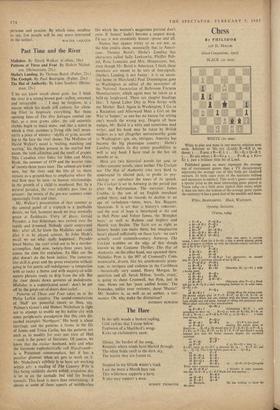Chess
(Good Companions, 1917) BLACK (to men)
WHITE (to men)
White to play and mate in two moves; solution next week. Solution to No. 215 (Loyd): R—KB 3!, no threat. . . . B any; 2 R—K 2. . Kt x R; 2 Q—R 7. ... Kt any other; 2 R—Kt 4. I . P—K 4; 2 Kt— Kt 5. Just a brilliant little bit of Loyd.
Published games no more represent the average run of tournament games than a TV documentary represents the average run of life; both are idealised extracts. In both cases most of the inartistic tedium and messiness is omitted. This week's game—awarded a special prize as the most interesting game played at Varna 1964—is a little more typical than most; while it does not have the tedium of the average game (quite the contrary) it has a good deal of the muddle and mess.
White, BRADVAREVIC. Black, Wazjuicov. Opening, SICILIAN.
(Varna, 1964)
sound, I don't think ihe.6 B—Kt 5 line Is worth playing unless one is prepared to follow up with the (double-edged) sacrifice of the Q Kt P by 7 Q—Q 2.
play R 3 and keep control of his Q Kt 4.
rr P—Q R 3! P—R 5
rporQ 3 P—Q R 4? Too aggressive; he should to B—K_3 Q—B 2 13 Kt—Q 4 Kt x Kt Otherwise Kt (4)—Kt 5 with a Kt—K B 3 P 3 4 Kt—PQ B 3 Kt--K 3 3
6 B—K Kt 5 Q—Kt 3 9 0-0 0-0 8
7 1(1-10 while this move is entirely
7 B—K B-1C a P—K P—K 4 P1B 4
Px 3 3
a strong same.
14 B x Kt B—Q a rs Q—Kt 3 B—B3 r6 P—B 4! Q R--Q
17 K—R r . . . Otherwise after P—Q 4 Black will get in B—Q B 4 later exchanging bishops or, in some eases. Q—Kt 3 ch. 1P—Q4 to .13.—:K P. . . Going off on the wrong track. He should simply play 18 P x P, B x P; to Kt x B, R x 13; 20 P—B 3 and White has two bishops with the better chances in both middle and end game. Instead of taking this positional plus. White plays tactically—but miscalculates. • . — Q—Kt 3 19 P—B 5 P . . threatening B—B 7 and intending to meet to . R—Q 2; with. 20 B x Kr, B x13; 21 P—K 5, B—Q t; 22 P—B 6, P—Kt 3; 23 Q—Kt 5 . . . it looks very strong, but . . . P—%51 io B—B 7 Q— 4 20 . P is also goodIt at P—K . . . missi7 t subtle point of Black's 20 .. —11 4. He should play 21 x R, B x B; 22 P—K 5, P x Kt; 23 P,x t, B x P; 24 Kt P x P, P xP and Black's strong bishops give him the better chances despite the sacrificed exchange. R—Q a • . as x. Kt B x P 23 P x P . . . if 23 Kt—Q t then 23 R x Bl; since 24 Q x R?? is defeated by 24 . . B x P ctrl and
25 Q x Q. This is the hidden point of 20 Q—B 4.
23 . . . P x P
24 Kt R B 13— as BxPc 1C—R 26 Ki—Q 5 . .B x Kt
27 B x B R—K 2 27 Q x P; 28 Q—Q 6 gives White more counter-chances. a8 Q—K 3? . . a blunder in time pressure, but after 28 B—R . Q x P Black will win anyway... 28 — 14—K6 29 Q—R S 11—K 4
30 R—B5 QxB
31 Resigns. He has nothing to show fur the piece.


































 Previous page
Previous page